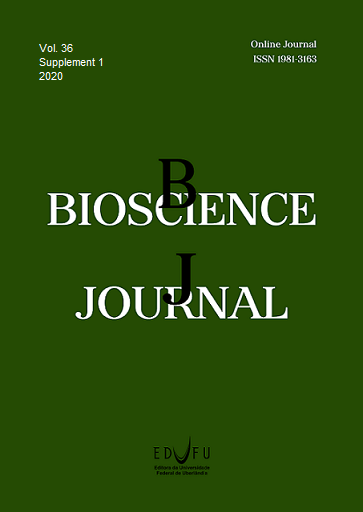Synergistic effects of binary mixtures of linalool with pyrethroids against fall armyworm
DOI:
https://doi.org/10.14393/BJ-v36n0a2020-53972Keywords:
Deltamethrin, Insecticidal activity, Spodoptera frugiperdaAbstract
The present work aimed to determine the toxicity of linalool and evaluate the lethal and toxic effects of linalool associated with pyrethroids in binary mixtures to fall armyworm (Spodoptera frugiperda). The insects used in the experiment were obtained from stock breeding initiated from larvae collected from conventional corn plants, grown in an experimental area, in the city of Uberlândia, Minas Gerais. Also, it was obtained essential oil from a variety of Ocimum basilicum, with a high content of linalool (80%), found naturally, as a measure of comparison of different linalool (97.5%) assays. Dose-response bioassays with 3rd instar larvae were performed to determine lethal dose for 50% mortality (LD50) of linalool. Toxicity tests were also performed with O. basilicum essential oil and with pyrethroid insecticides: deltamethrin and its commercial product (Decis 25 EC, Bayer®). After this, combinations between different doses of these products were made and applied on 3rd instar larvae of Spodoptera frugiperda (Smith). Linalool presented high toxicity to S. frugiperda (LD50 = 0.177 μL a.i. μL-1). It was observed neurotoxic effects after the linalool application since the insects presented an aspect of confusion, followed by extreme agitation and finally death. All binary mixtures caused mortality higher than the products applied alone (deltamethrin and linalool) used at 100% LD50, except to 75% LD50 deltamethrin added to 25% LD50 linalool, whose mortality did not differ the products alone, in 24 hours. It was obtained over 90% larval mortality when linalool was combined with 25% LD50 of deltamethrin, in 24 and 48 hours after application, and over 80% of mortality when linalool was combined with 25% LD50 of Decis, only in 48 hours after application. We conclude that linalool is a potential insecticidal and can be associated with pyrethroids to control of S. frugiperda. Further studies are required in order to evaluate the synergistic combinations against field populations of S. frugiperda.
Downloads
Published
Issue
Section
License
Copyright (c) 2020 Sérgio Macedo Silva, João Paulo Arantes Rodrigues da Cunha, César Henrique Souza Zandonadi , Heli Heros Teodoro de Assunção, Matheus Gregorio Marques

This work is licensed under a Creative Commons Attribution 4.0 International License.





